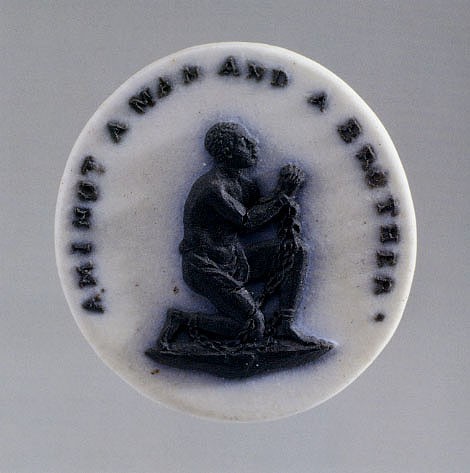
Medallion, Josiah Wedgwood, Staffordshire, England, ca. 1787. Jasperware. D. 1 1/8". (Chipstone Foundation; photo, Gavin Ashworth.) Design of chained and kneeling slave in profile taken from the seal of the Society for the Abolition of the Slave Trade

Medallion, Josiah Wedgwood, Staffordshire, England, ca. 1787. Jasperware and silver. D. 1 7/8". (Collection of Rex Stark; photo, Gavin Ashworth.)

Patch box, England, ca. 1800. Painted enamel on metal. L. 1 3/4". (Collection of Rex Stark; photo, Gavin Ashworth.)
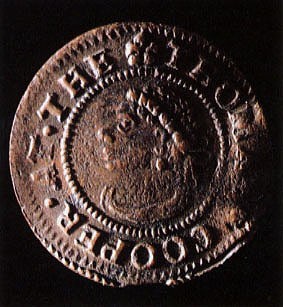
Halfpenny token, 1668. Copper. D. 7/8". (Collection of the author; photo, Gavin Ashworth.) Head of black youth representing the Black Boy Pub.
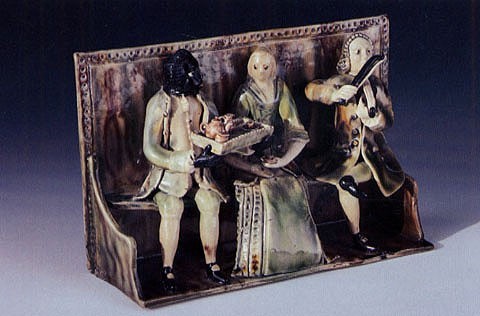
Figural group, Staffordshire England, ca. 1760. Creamware. H. 5 3/8". (Courtesy, Colonial Williamsburg Foundation.)

Cream jug, Staffordshire or Yorkshire, England, 1780–1790. Creamware. H. 4 1/2". (Collection of the author; photo, Gavin Ashworth.) This jug, part of a larger tea service, has twisted strap handles with molded sprigs terminals and a black transfer print of The Tea Party.

Jug, England, ca. 1800. Pearlware. H. 9 1/2". (Collection of the author; photo, Gavin Ashworth.) Armorial crest featuring blackamoor bust in profile.
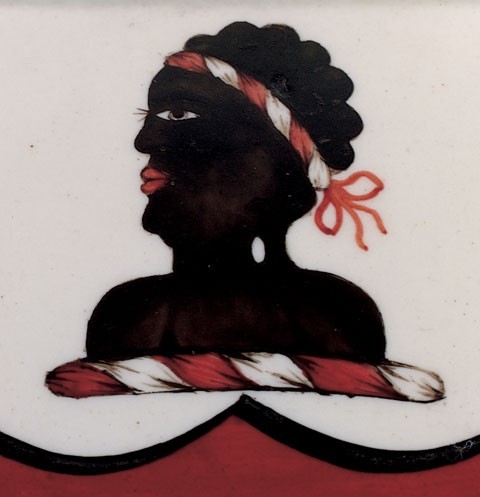
Detail of the crest illustrated in figure 7.
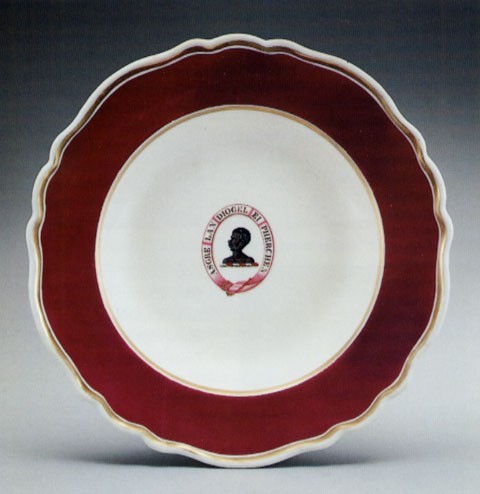
Soup plate, France, ca. 1810. Porcelain. D. 9 3/4". (Collection of the author; photo, Gavin Ashworth.) Blackamoor head and legend “Asgre Lan Diogel ei Pherchen.”

Detail of the soup plate illustrated in fig. 9. The Latin legend translates as “A pure conscience is a safeguard to its possessor.”
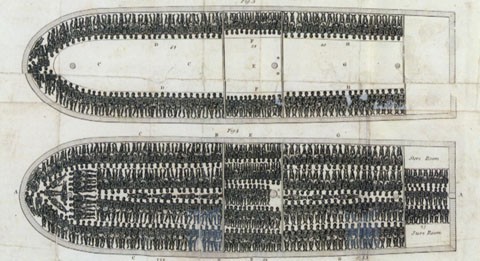
Detail of an engraving, from Thomas Clarkson’s History of the Abolition of the African Slave Trade, London, 1807. Influential figures such as Thomas Clarkson were given the responsibility of collecting information to support the abolition of the slave trade. This included interviewing 20,000 sailors and obtaining equipment used on the slave ships such as iron handcuffs, leg-shackles, thumb screws, instruments for forcing open slaves’ jaws, and branding irons. In 1787 he published his pamphlet, A Summary View of the Slave Trade and of the Probable Consequences of Its Abolition. After the abolishment of the British slave trade in 1807, Clarkson published his book History of the Abolition of the African Slave Trade.
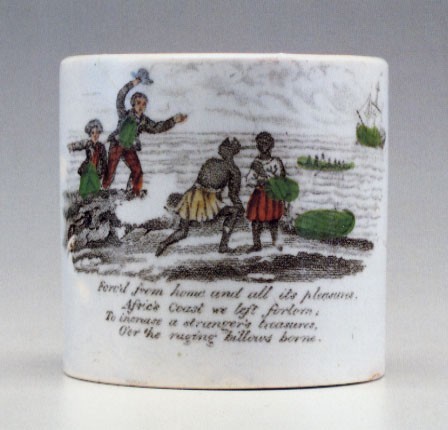
Child’s mug, England, ca. 1840. Whiteware. H. 2 1/2". (Collection of Rex Stark; photo, Gavin Ashworth.) This enamel-colored black transfer print depicts the capture of native Africans by European slavers, along with the opening verse from William Cowper’s The Negro’s Complaint: “Forcd from home and all its pleasures/Afric’s coast we left forlorn/To increase a stranger’s treasures/O’er the raging billows borne.”
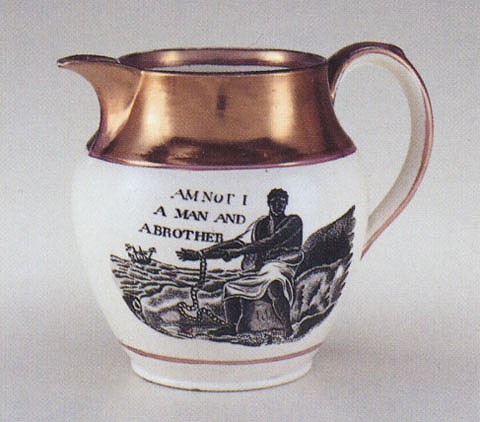
Jug, Staffordshire or Sunderland, ca. 1820. Pearlware. H. 4 1/2". (Collection of Rex Stark; photo Gavin Ashworth.) This jug with copper and pink luster trim shows a transfer-printed variation of the Wedgwood plaque design. This one features a frontal view of a chained and seated slave, and verses from William Cowper’s The Negro’s Complaint on the other side. Note the reversal, most likely unintentional, of “I” and “Not” in the printed motto.
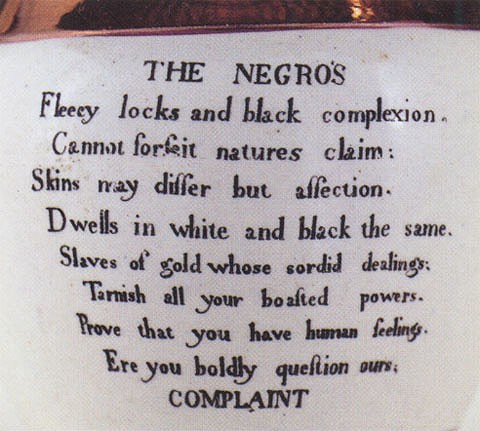
Detail of the reverse of the jug illustrated in fig. 13. This stanza from The Negro’s Complaint reads (italics mine): “Slaves of gold, whose sordid dealings/ Tarnish all your boasted powers,/Prove thatyou have human feelings/Ere you proudly question ours!”

Figural group, France or England, ca. 1820. Porcelain. H. 6 1/4". (Collection of Rex Stark; photo, Gavin Ashworth.) A late eighteenth-century antislavery pamphlet by William Fox included a section on punishment in which a Royal Navy admiral attested that the flogging of slaves was much more severe than that administered to sailors aboard English men-of-war. More explicitly, an English general asserted “there is no comparison between regimental flogging, which only cuts the skin, and the plantation, which cuts out the flesh.”
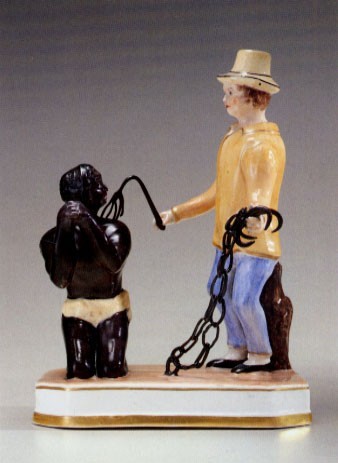
Reverse view of the figural group illustrated in fig. 15.

Mug, England, ca. 1850. Porcelain H. 3". (Collection of Rex Stark; photo, Gavin Ashworth.) In elaborate gold script: “Health to the Sick/ Honour to the Brave/Success attend true Love/ And Freedom to the Slave."
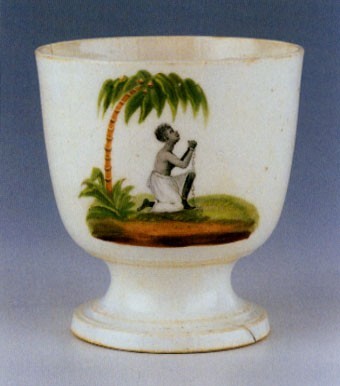
Sugar bowl, England, 1820–1830. Bone china. H. 4 5/8". (Courtesy, Colonial Williamsburg Foundation.) The decoration of the kneeling slave in the tropical environment is enameled over the glaze suggesting that it may have been produced for a special anti-slavery fair or occasion.
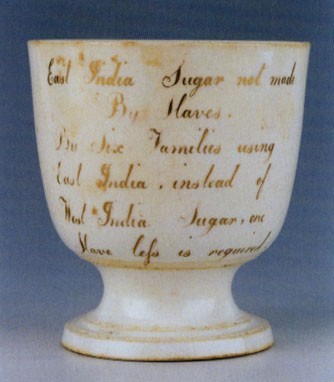
Reverse of the sugar bowl illustrated in fig. 18. Legend reads: “East India Sugar not made/By Slaves/By Six families using/East India, instead of/West India Sugar, one/Slave less is required.” The wording represents a somewhat sanitized version of Fox’s formulation that “A family that uses 5 lb. of sugar per week...will, by abstaining from the consumption 21 months, prevent the slavery or murder of one fellow creature” and tactfully omits the pamphleteer’s more gruesome analogy “that in every pound of sugar used...we may be considered as consuming two ounces of human flesh.”
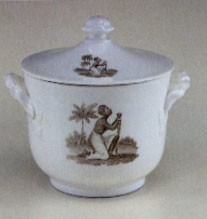
Sugar bowl and cover, England, 1820–1830. Earthenware. H. 5". (Collection of Rex Stark; photo, Gavin Ashworth.) Transfer-printed image of the kneeling slave. This bowl would have been part of a larger tea service. A number of different ceramic forms were decorated with this transfer print, including teawares and dinnerwares.
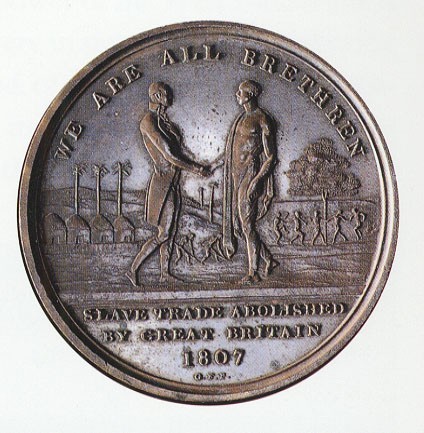
Token, 1807, copper. D. 1 3/8". (Collection of the author; photo, Gavin Ashworth.)

Reverse engraving on glass, London, 1807. (Courtesy, Colonial Williamsburg Foundation.) Published to commemorate the abolishment of the British slave trade, this depiction, rich in iconographic imagery, shows the figure of Africa casting a disapproving eye toward America who holds the images of Washington and Franklin.
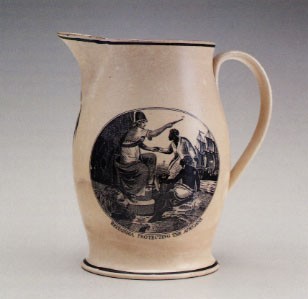
Jug, Liverpool, 1805–1810. Creamware. H. 8 1/4". (Collection of Rex Stark; photo, Gavin Ashworth.) The transfer on this jug is captioned: “Britannia Protecting the Africans.”

Figure, Staffordshire, 1790–1810. Pearlware. H. 7". (Collection of Rex Stark; photo, Gavin Ashworth.) This early kneeling slave, hand enameled in high temperature underglaze colors, is holding a book inscribed “bless god thank briton me no slave.” While not specifically identified as such, the early date of this ceramic figure must coincide with the British abolishment of the slave trade begun in 1792 and formally decreed in 1807.

Figural group, possibly Staffordshire, early nineteenth century. Porcelain. H. 6 5/8". (Collection of Rex Stark; photo, Gavin Ashworth.) In this figural group, a slave exults in freedom as broken chains and whip lie on the ground. An open Bible rests at Britannia’s feet.
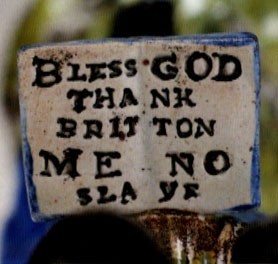
Detail of the inscription on the book held by the kneeling figure illustrated in fig. 24.
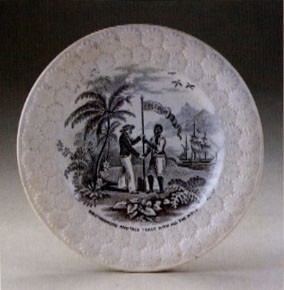
Plate, England, ca. 1840. Whiteware. D. 8". (Collection of Rex Stark; photo, Gavin Ashworth.) Molded daisy pattern rim with black transfer print advocating “Brotherhood and Free Trade with all the World.”
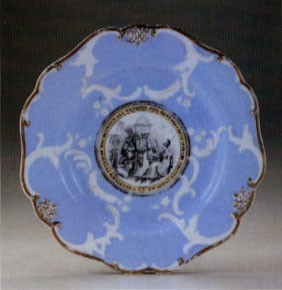
Plate, France or England, ca. 1830. Porcelain. D. 9". (Collection of Rex Stark; photo, Gavin Ashworth.) Inscribed “Unfettered Intercourse between all Nations—The Best Security for Abundance and Peace.”
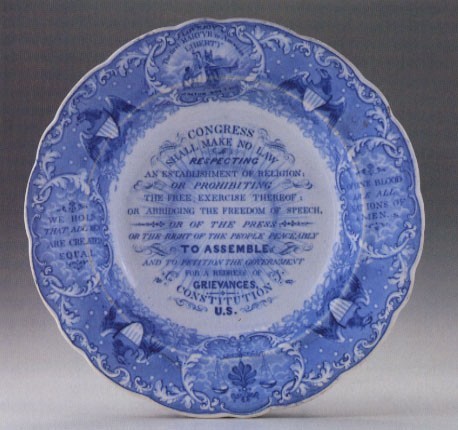
Soup plate, Staffordshire, ca. 1840. Whiteware. D. 10 1/2". (Collection of Rex Stark; photo, Gavin Ashworth.)
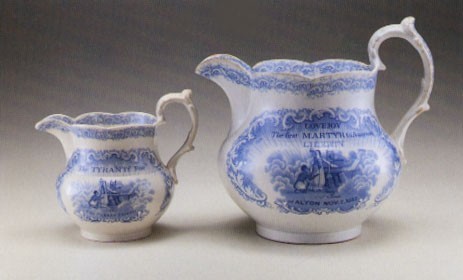
Jugs, Staffordshire, ca. 1840. Whiteware. H. of tallest. 6 1/4". (Collection of Rex Stark; photo, Gavin Ashworth.)

Jug, Staffordshire, ca. 1840. Whiteware. H. 4 1/4". (Collection of Rex Stark; photo, Gavin Ashworth.)
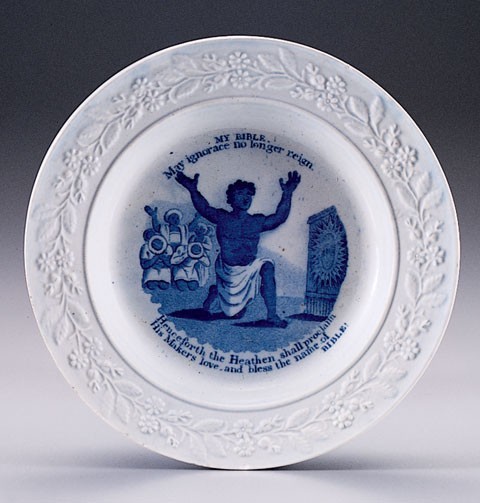
Child’s plate, England, ca. 1820. Pearlware. D. 5". (Collection of the author; photo, Gavin Ashworth.) This blue transfer print extolling the virtues of “my bible” is derived from a color sheet published by William Darton, Jr. in 1812.

Vase, France, ca. 1820. Porcelain. H. 4 3/4". (Collection of Rex Stark; photo, Gavin Ashworth.)

Detail of the inscription on the vase illustrated in fig. 33.
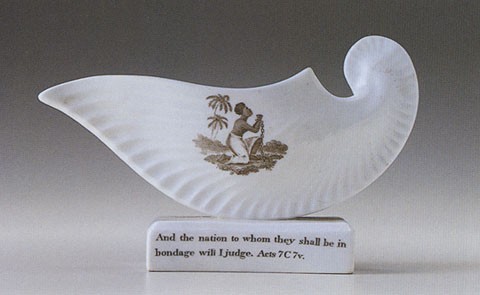
Sauceboat, France, ca. 1820. Porcelain. L. 5 1/2". (Collection of Rex Stark; photo, Gavin Ashworth.) Black transfer print of a kneeling female slave in chains.

Dish, France, ca. 1820. Porcelain. L. 10". (Collection of Rex Stark; photo, Gavin Ashworth.)

Cup and saucer, England, ca. 1830. Drabware. D. 5 1/8". (Collection of the author; photo, Gavin Ashworth.) Black transfer print of kneeling female slave in chains (cup).

Detail of the saucer illustrated in fig. 37.

Detail of the saucer illustrated in fig. 37.

Plate, England, ca. 1830. Drabware. D. 6 1/2". (Collection of Rex Stark; photo, Gavin Ashworth.) This small plate, part of a larger tea service, bears the caption from the engraving which faces the title page in Mary Dudley’s pamphlet, Scripture Evidence of the Sinfulness of Injustice and Oppression: “This Book tell Man not to be cruel; Oh that Massa would read this Book.”
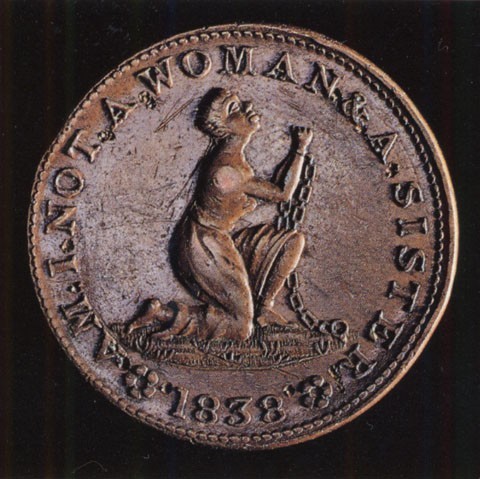
Token, United States, 1838. Copper. D. 1 1/8". (Collection of the author; photo, Gavin Ashworth.) Kneeling and chained female slave with legend: “am i not a woman & a sister.”

Candlestick, England, ca. 1830. Earthenware. H. 6 1/4". (Collection of Rex Stark; photo, Gavin Ashworth.) This unusual form has the transfer print of a kneeling female slave and the Bible verse: “Remember them that are in Bonds.”
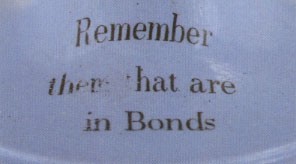
Detail of the gilt inscription on the base of the candlestick illustrated in fig. 42.
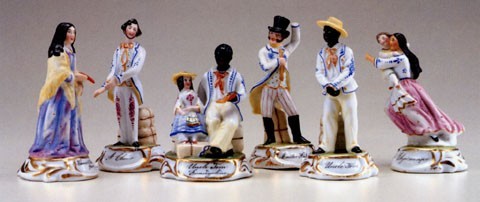
Set of figures from Uncle Tom’s Cabin, England, ca. 1855. Unglazed porcelain. H. of tallest: 3 1/4". (Collection of Rex Stark; photo, Gavin Ashworth.)

Plate, probably Staffordshire, ca. 1855. Whiteware. D. 6 1/6". (Collection of Rex Stark; photo, Gavin Ashworth.) The printed scene shows “The Death of Uncle Tom.”

Plate, J. Vicellard, Bordeaux, France, ca. 1855. D. 8". (Collection of Rex Stark; photo, Gavin Ashworth.) A French version of the death of Uncle Tom.
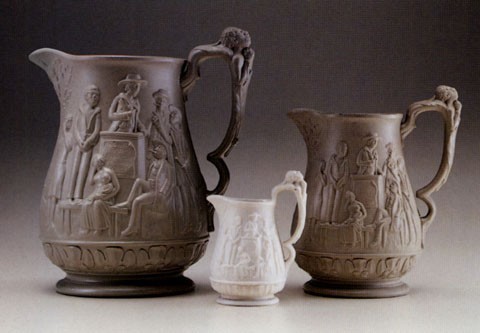
Pitchers, Ridgway & Abingdon, Staffordshire, 1855. Colored stoneware and parian. H. of tallest: 8". (Collection of Rex Stark; photo, Gavin Ashworth.) The molded images are taken from two scenes in Uncle Tom’s Cabin, with the side shown depicting a slave auction. The three-dimensional handle shaped as a kneeling slave represents nearly seventy years use of that poignant image since the introduction of Wedgwood’s medallion in 1787.
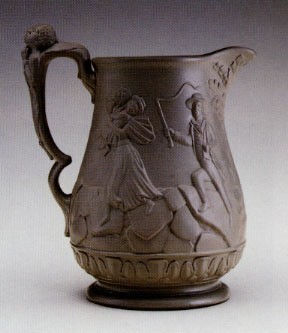
Reverse of the jug illustrated in fig. 47.

Child’s plate, England, ca. 1850. Whiteware. D. 5 3/8". (Collection of the author; photo, Gavin Ashworth.) Enamel-colored black transfer print “jump jim crow,” with molded rim.
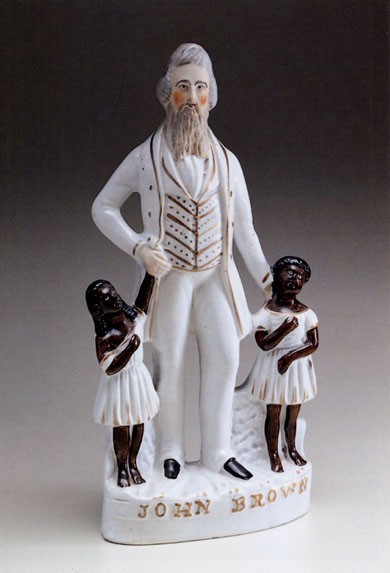
Figure, Staffordshire, ca. 1860. Whiteware. H. 11". (Collection of Rex Stark; photo, Gavin Ashworth.) The molded, hand-enameled figure of militant abolitionist John Brown contrasts sharply with the diminutive, adoring children.
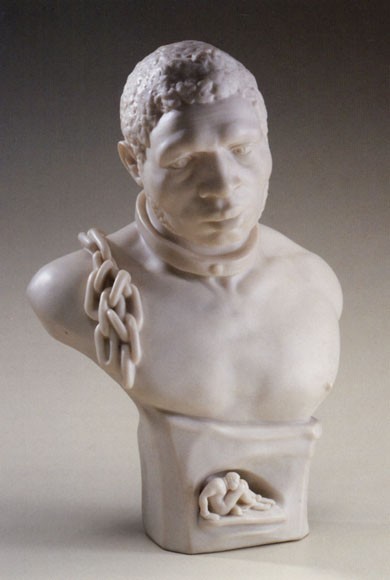
Bust, Copeland, Staffordshire, 1864. Parian. H. 9 3/4". (Collection of Rex Stark; photo, Gavin Ashworth.) This powerful sculptural expression of a chained slave with collar is among the most artistically-proficient and dramatic images of slavery. A confined full-body slave is represented in a recess on the base. The base is marked “Published May 1, 1864 Copeland.”
